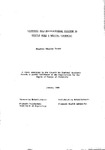LEARNING AND INSTRUCTIONAL SUCCESS IN PEOPLE WITH A MENTAL HANDICAP
| dc.contributor.author | Strand, Stephen Charles | |
| dc.contributor.other | School of Psychology | en_US |
| dc.date.accessioned | 2013-09-18T11:31:19Z | |
| dc.date.available | 2013-09-18T11:31:19Z | |
| dc.date.issued | 1989 | |
| dc.identifier | NOT AVAILABLE | en_US |
| dc.identifier.uri | http://hdl.handle.net/10026.1/1845 | |
| dc.description.abstract |
Learning - the process by which new skills and behaviours are acquired - is a central concept in the understanding of mental handicap. Discrimination learning Is specifically identified as an essential pre-requlslte for the acquisition of a variety of more complex behaviours and skills. Many studies have reported that severely mentally handicapped persons show a relative inability to profit from unstructured learning experiences, and frequently fail to learn discriminations trained through simple differential reinforcement (trial-and-error training). Programmed training procedures are identified as important vehicles to facilitate the discrimination learning of severely mentally handicapped children. An initial study is reported that confirms the superiority of programmed over trial-and-error discrimination training, and demonstrates this superiority is maintained over a series of similar discrimination tasks. The results also demonstrate that stimulus fading procedures can be successfully implemented using micro-computer technology, and that 'errorless' learning can be effected through the sequencing and fading of trainer prompts. However, programmed procedures are not invariably effective in teaching discriminations to developmentally impaired persons, and failures to learn following programmed training are not infrequently reported. In a series of studies, some of the basic procedural parameters underlying diverse programmed techniques were evaluated as determinants of the development (or lack of development) of appropriate stimulus controL Increasing the salience of S+, whether through manipulation of S+ or S-, was shown to be more effective than increasing the salience of S-. Further, congruence between prompt and training cue dimensions was shown to be a significant variable affecting the outcome of training. The effectiveness of programmed procedures was also shown to interact with task difficulty. Finally, wide individual differences in learning within the population of severely mentally handicapped persons have frequently been reported, and were also observed in the present research. In a final study, individual differences in some basic cognitive abilities and aspects of classroom behaviour were assessed and shown to be significantly correlated with discrimination performance. The results are related to the literature on compound conditioning (e.g., Kamin, 1968) and theories of discrimination learning (Terrace, 1966; Rescorla & Wagner, 1972; Zeaman and House, 1963, 1979), and suggest the importance of attentlonal processes in discrimination learning. Lastly, some educational implications of the results are discussed. | en_US |
| dc.description.sponsorship | Plymouth Health Authority | en_US |
| dc.language.iso | en | en_US |
| dc.publisher | University of Plymouth | en_US |
| dc.title | LEARNING AND INSTRUCTIONAL SUCCESS IN PEOPLE WITH A MENTAL HANDICAP | en_US |
| dc.type | Thesis | |
| plymouth.version | Full version | en_US |
| dc.identifier.doi | http://dx.doi.org/10.24382/1455 | |
| dc.identifier.doi | http://dx.doi.org/10.24382/1455 |
Files in this item
This item appears in the following Collection(s)
-
01 Research Theses Main Collection
Research Theses Main


